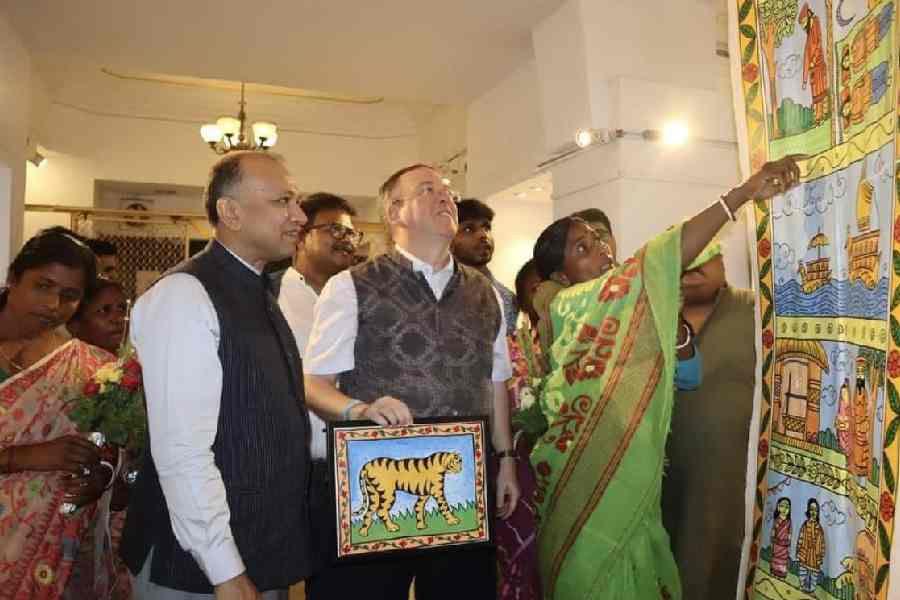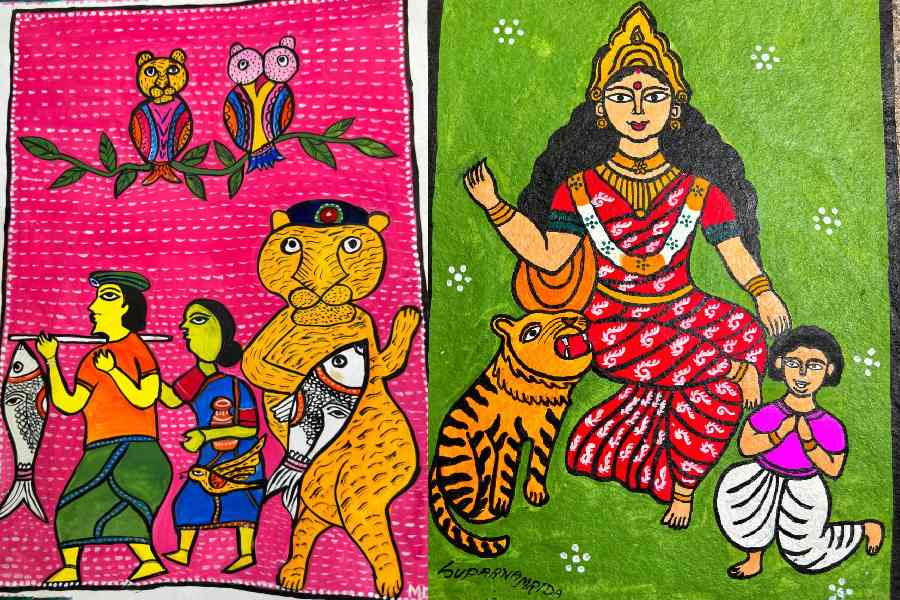A lost art from the land of mangroves and tigers is the subject of an ongoing exhibition at a south Calcutta gallery.
Over 50 paintings inspired by the patachitra or scroll painting of the Sunderbans are on display at the gallery in Southern Avenue in the exhibition, supported by the forest department.
Patachitra, or cloth-based scroll painting, is one of the oldest folk art forms of Bengal. The content on the scroll ranges from mythological lore and folk tales to social sagas. Back then, patuas would carry the scrolls to village fairs and sing the stories painted on them.

A resident of the Sunderbans explains a life-sized scroll to Niraj Singhal, the head of the forest force in Bengal; Milan Mandal, the DFO of the South 24-Parganas division; and Andrew Fleming, the British deputy high commissioner, at the exhibition on Tuesday.
The patachitra of Kalighat and Midnapore are well known. But the form once thrived in the Sunderbans as well. The absence of a sustainable revenue model and the geographical location of the mangrove delta possibly led to its decline.
A group of women from villages around Jharkhali near the Sunderbans Tiger Reserve made the paintings. The Calcutta exhibition is part of a campaign to generate an alternative livelihood for local women by reviving a lost art form.
The campaign has seen two training programmes — in 2022 and 2023 — that saw local women get trained in scroll art by a professional artist.
The local environment is inseparable from local art. The patachitra of Sunderbans drew from the tales of local legends like the Bon Bibi (the protector of humans and the forest) and the tiger. The paintings are an extension of the same.
The three-day exhibition opened on Tuesday. Till Wednesday evening, a dozen paintings were sold. Each painting costs Rs 1,000, said an organiser.
“I came to know about the exhibition from social media,” said Ayanangshu Samaddar, who bought four paintings from the exhibition at Gallery Gold.
Most of the women who are part of this venture are dependent on the forests for survival. They sustain themselves by catching crabs and prawns in shallow creeks, a venture fraught with the threat of tiger attacks.
One of them is Debika Burman, 32. Debika was among the women present at the gallery on the inaugural day. “We did pencil sketches first and then coloured them. The last step was to frame the
paintings,” said Debika, a mother of two. Deserted by her husband, Debika used to venture into the creeks to catch crabs till last year.
“The campaign has the potential to generate an alternate income for the local population and protect the ecosystem. We want to scale it up in the coming days,” said Milan Kumar Manadal, the divisional forest officer of South 24-Parganas forest division.
Mandal accompanied Niraj Singhal, the head of forest force in Bengal, at the inauguration on Tuesday. The British deputy high commissioner to Calcutta, Andrew Fleming, was among the attendees.
Sourav Mukherjee, founder of the Kolkata Society for Cultural Heritage, an NGO that has steered the campaign, said the exhibition was an attempt to make a mark in
Calcutta.
“We have clients in the Netherlands, the US, the UK. Studios in Mumbai and Goa have purchased the products. We have in the past displayed our products at a Durga Puja in Salt Lake. But this is our first proper exhibition in Calcutta,” he said.
